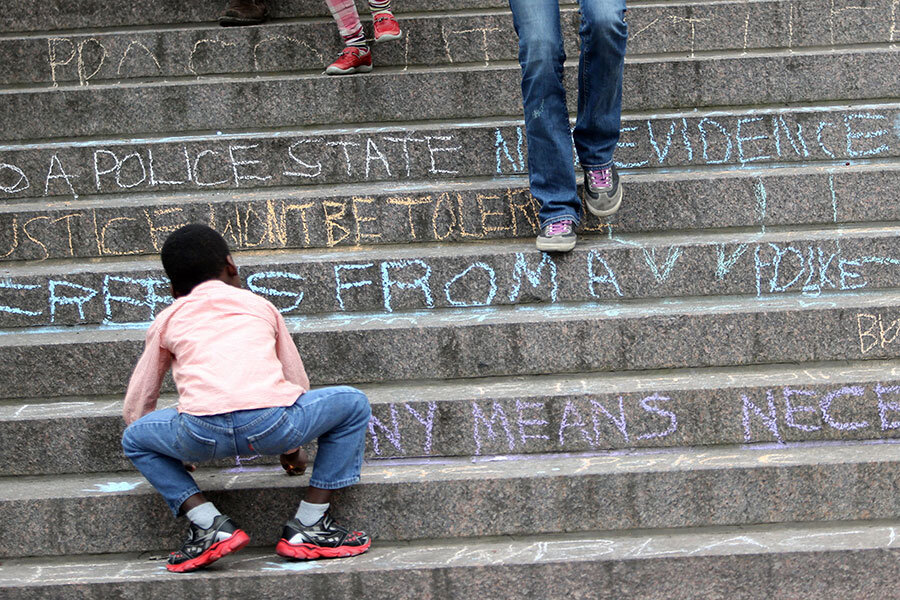Why concern about race relations has jumped – for whites and blacks
Loading...
The number of Americans who are concerned “a great deal” about race relations has more than doubled in the last two years, reflecting what experts see as growing but differing grievances among America’s black and white communities.
Some 35 percent of Americans are now worried “a great deal” about race relations, according to a Gallup poll released Monday. That's up from 17 percent two years ago is the highest since Gallup began polling on the issue in 2001. The previous high was 28 percent in 2001 and again in 2015.
As has long been the case, concern on the issue is much higher for blacks than for whites, but it has jumped for both groups.
The heightened sense of racial division may reflect a confluence of two forces.
First is that the optimism prevalent when President Obama took office has been tempered both by acrimony over criminal-justice issues, as well as the view that Mr. Obama has failed to deliver as much as many blacks had hoped.
Second may be the rise of a contrasting view for many white Americans: the feeling that they are being left behind in a weak economy – and that one reason is the rise of racial minorities in population and political clout.
The poll responses don’t speak directly to the reasons behind the shifting views. But race-relations experts say these two views are important factors, which take most obvious form in the “Black Lives Matter” movement and the white-America nativism of Donald Trump.
For the black community, perhaps no issue is so significant as the instances of unarmed black men dying at the hands of police, such as Michael Brown in Ferguson, Mo., and Freddie Gray in Baltimore.
“For African Americans the high-profile incidents increase the perception that the police are at war with young black men,” says Carol Swain, a Vanderbilt University professor of law and political science who has written extensively on American race relations.
The Gallup poll found 53 percent of blacks are worried “a great deal” about race relations in 2016, up from 31 percent in 2014, while for whites the share grew from 14 to 27 percent.
Wider economic and social conditions are also a factor in the changes, Swain says. She notes the black community faces persistent economic challenges, despite the hopes they had pinned on the Obama administration. (Black unemployment has improved under Obama, but remains twice as high as for whites. And black households on average have taken a big hit to net worth and not recovered since the recession, for example.)
Other economic shifts during Obama's tenure have also hurt blacks economically, notes Mark Naison, a professor of history and African American studies at Fordham University in New York. These include a wave of home foreclosures following the financial crisis, which increased the black-white wealth gap, plus a state-level trend of privatizing public services, in which blacks were disproportionately employed.
“The combination of those two: millions of people losing their homes and the privatization of public services have hit [African Americans] very hard,” he says.
Whites have also grown less sanguine about race relations.
If some whites are registering their concern for the treatment of blacks, others may be feeling worried by an increasingly diverse America – where whites can be a minority in many communities.
Swain and Mr. Naison both say that the sense of economic disenfranchisement sparking racial tensions has not been limited to America’s black community.
Naison says this is the backdrop for the rise of Mr. Trump, and it has fanned the perceived deterioration of race relations not only among blacks and whites, but also other American minorities.
“If people perceived divisions [last year], that was nothing compared to what Donald Trump unleashed,” he says, adding that his Latino, black, and Muslim students are “terrified and enraged” at Trump's popularity, and also by news of physical attacks and racial slurs against blacks at his rallies.
Swain says some whites perceive affirmative-action type policies as well as liberal immigration policies as contributors to their worsening condition.
In her 2002 book, “Voices of Contemporary White Nationalism in America,” Swain suggested that an increase in racial consciousness and a sense of disenfranchisement among white Americans would be “the next logical stage for identity politics in America.” The claim is that “a part of the future discord will come from the rising expectations and demands of racial and ethnic minorities, which are sure to increase as minorities become a larger portion of the American population."
The bottom line, Gallup concludes, is that optimism about race relations has shifted from where it stood when Obama was elected, and 7 in 10 Americans “believed race relations would improve because of his victory.”






